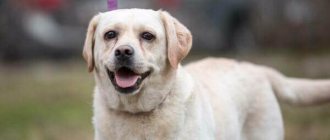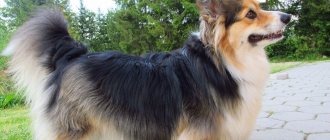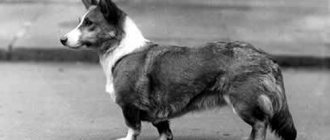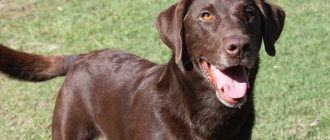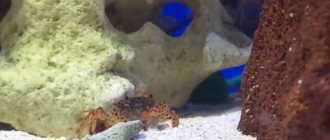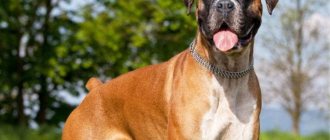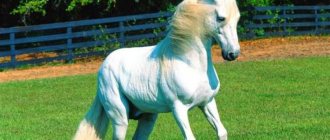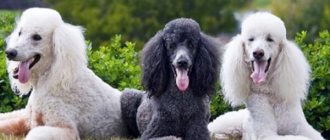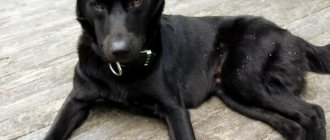History of the origin of the breed
Even in ancient times, there were animals that looked like a poodle. The breed received its name in France in the 15-16th century and the dogs were mainly found among hunters, travel enthusiasts and sailors. Small-sized dogs were bred in the country and were companions of traveling artists and musicians, performed in circuses and were popular as truffle-hunting animals.
The homeland of the poodle dog breed is a country such as France. At the very beginning, dogs were used for hunting, but gradually the French king Henry 4 began to use them for his own protection. A variety such as the Royal Poodle appeared as a result of the increase in the breed of royal individuals.
For some time, only representatives of the French aristocracy had the right to have a poodle at home, and if the law was violated, a person was overtaken by death.
Some time after Europe entered the path of democracy, hunters were able to have faithful assistants in the form of dogs of this breed. This breed of dog was primarily used for catching waterfowl. The poodle's body is covered with hair in the form of rings that fit tightly together, which helped the dogs avoid severe hypothermia in the water and injuries.
However, the animals' fur is too long and, when wet, interferes with movement. For this reason, over time, hunters began to give their pets haircuts.
On the territory of Red Moscow, this breed of dog appeared in the 19th century after the conquest of Europe took place. During the Great Patriotic War, poodles helped carry the wounded from the battlefields, looked for mines and had close contact with scouts.
Varieties of the poodle breed with photos
The poodle breed is divided into 4 types, taking into account height at the withers. However, dog experts say that these indicators do not serve as the only criterion in determining the type of poodle. There is some difference in the size and weight of animals, as well as in their character and habits.
Large (standard)
A standard poodle is also called a royal poodle and the height of such a dog is 45-60 cm. A dog of this size requires appropriate living conditions and a play area. The Standard Poodle can be successfully trained and can become a hunting or service dog. The standard breed poodle treats others kindly and is therefore not capable of causing harm to its owner.
Average
The medium-sized poodle reaches a height of 35-45 cm, and their character has many similarities with the royal variety. The animals are quite obedient, balanced and hardy. From birth, the pet is endowed with a sense of self-esteem and adapts well to life in an apartment. Despite this, such a dog requires mandatory long walks with physical exercise.
Dwarf
The size at the withers of a dwarf poodle is 28-35 cm. Dogs of this size look quite cute and gentle, but they have a fairly hardy character. If they do not receive enough love, they can become jealous of the owner and at the same time always require increased attention.
A poodle of this breed is considered to be a fairly energetic dog who loves to play with children and misbehave. In addition, the toy poodle is considered a fairly loyal dog.
Toy (smallest)
The toy poodle resembles a toy in appearance and its height reaches only 24-28 cm. However, this type of pet is considered quite proud, so you should not take it seriously. One of the disadvantages of a toy poodle is its miniature size, and it constantly barks. However, a pet may bite if they refuse to recognize it as a full-fledged dog.
Owner reviews
Most owners speak of poodles as wonderful companions who sincerely love their owners and get along well with children. There are also positive reviews about the intelligence of the pets and the ease of their training.
Among the disadvantages are the need for careful care of the coat, changeable character, frequent illnesses in puppyhood, and hyperactive behavior.
As a conclusion, we can say the following. Poodles are excellent dogs for living in apartment conditions, especially the small, dwarf and toy varieties. A royal pet will need quite a lot of space. Despite all the positive qualities, it is worth remembering that a dog is not a toy, and it will need to be given attention, as well as properly raised, in order to ultimately become a worthy family member.
Poodle colors
Poodles are a dog breed that comes in a variety of colors. In some cases, when pets are crossed, puppies with very unusual colors are born. Cynologists distinguish 6 main colors of poodles:
- Black poodle. This dog color is considered classic. The fur is black and has no markings. Through the coat of a black poodle, you can see blue or gray skin.
- White poodle. This coat color is considered quite common. Puppies may have slight patches of cream or apricot color on the ears, paws and chest.
- Chocolate Poodle. The pet's fur is uniformly rich brown. The ears of a brown poodle are slightly lighter in tone, and the eyes can be amber or brown.
- Silver poodle. The gray color is considered quite complex and develops in puppies over several years. Initially they are born black, and it is possible to assume that the coat will become silver only after 6 weeks.
- Red poodle. The coat of these dogs has a mahogany shade. The nose and rim of the Red Poodle can be either brown or black.
- Peach poodle. A dog's coat can be any shade of apricot color, and the color becomes lighter as the puppy gets older. Some adult dogs may lose their peachy hue and become a cream color.
In recent years, dog colors such as Harlequin, that is, a combination of white and black, and black and tan, have been recognized. In addition, you can meet red and blue poodles.
POODLE (Caniche) Translation: Shchuko Y., Lutokhina O. Country of origin: France Date of publication of the current original text of the standard - 03/06/2007. Use: Companion dog FCI classification: Group 9. Companion dogs. Section 2. Poodle. No operational tests.
Brief historical background: The French name of the breed “caniche” (poodle) comes from the French word “cane” - duck. In other countries, the breed is called a derivative of the word barboter (to splash). The poodle was originally used for hunting waterfowl. It originates from barbet and has retained many of its characteristic features. Since 1743, the name “la caniche” (poodle) appeared. The Barbet and Poodle subsequently split as breeds. Breeders have made great efforts to obtain the original appearance of the breed and uniform color. The Poodle has become very popular as a companion dog due to its friendly, cheerful and loyal nature, as well as four sizes and a variety of colors that anyone can choose according to their preferences.
GENERAL APPEARANCE: Medium lined dog with a characteristic curly or corded coat. Gives the impression of being an intelligent, constantly attentive, active, and also harmoniously built dog, which is very elegant and full of self-esteem.
IMPORTANT PROPORTIONS: The length of the muzzle is approximately 9/10 of the length of the skull. The length of the body is slightly greater than the height at the withers. The height at the withers is almost equal to the height of the croup. The distance from the ground to the elbows is 5/9 of the height at the withers.
BEHAVIOR/CHARACTER (CHARACTER): The dog is loyal, intelligent and trainable, which makes it a particularly pleasant partner.
HEAD: Refined, straight lines, proportional to the body. The head should be well sculpted, it should not look heavy, but also should not be too delicate.
Cranial part
Skull: Its width is less than half the length of the head. When viewed from above, the skull appears oval along the longitudinal axis; in profile it is slightly convex. The longitudinal axes are slightly divergent.
The brow ridges are moderately pronounced and covered with long hair.
Frontal groove: Wide between the eyes, tapering towards a very well defined occipital protuberance. (In miniature poodles, the nuchal protuberance may be less pronounced.)
Transition from forehead to muzzle: Very slightly pronounced.
Front part
Nose: Developed, vertical when viewed in profile, nostrils well open. Black, white and gray dogs have a black nose; in browns it is brown; in apricot and red poodles it is brown or black.
Muzzle: The upper profile is straight. The length of the muzzle is approximately 9/10 of the length of the skull. The lateral bones of the lower jaw are located almost parallel. The muzzle looks strong. The lower profile is formed by the jaw, not the lower edge of the upper lip.
Lips: Moderately developed, rather dry, of medium thickness. The upper lip lies on the lower lip without overlapping it. Black, white and gray poodles have black lips. Browns have brown ones; Apricot and red poodles may have brown, more or less dark, or black coats. The angle of the lip is not pronounced.
Jaws/Teeth: Scissor bite, strong teeth.
Cheekbones: The cheek muscles are not protruding, tightly fitting to the bones of the skull. The infraorbital region is well carved and little filled. The cheek bones protrude slightly.
Eyes: Fiery expression, located at the level of the transition from the forehead to the muzzle, set slightly obliquely. Almond-shaped eyelid section. The eyes are black or dark brown. Brown Poodles may have dark amber colored eyes.
Eyelids: The edges of the eyelids are black in black, white and gray poodles, brown in brown ones. In apricots and reds they are brown or black. Ears: Quite long and falling along the cheeks. The base is located on the continuation of the line emanating from the top of the nose and passing just below the outer corner of the eyelid. Flat, widening from the base, the tips are rounded, covered with long, wavy hair. The ear flap should reach the corners of the lips.
NECK: Strong, slightly convex nape line, medium length, good proportions; carries his head high and proud. Without the formation of a suspension. The neck is oval in cross section. Its length should be slightly less than the length of the head.
BODY: Poodle body of very good proportions; The length of the body is slightly greater than the height at the withers.
Withers: Moderately pronounced.
Back: Short, harmoniously contoured, straight, strong. The withers and croup should be at approximately the same height.
Loin: Strong and muscular.
Croup: Rounded, but not sloping.
Forechest: The top of the sternum should be slightly protruding and set fairly high.
Chest: Extends to elbows. The width is 2/3 of the depth. In large poodles, the circumference of the chest, measured behind the shoulder blades, should exceed the height at the withers by at least 10 cm. Oval ribs. Wide in the back area.
Lower profile and belly: Tucked up, but not undercut (like a greyhound).
Tail: Set fairly high, level with the loin. It can be long, shortened by one third or half of the natural length. When calm, the tail is lowered. When moving, the tail is carried obliquely upward.
LIMBS
FOREQUARTERS: Perfectly straight, parallel, well muscled and boned. The distance measured from the corner of the elbow to the ground should be slightly longer than the distance from the corner of the elbow to the withers.
Shoulders: Sloping, well muscled; The shoulder blade should form an angle of about 110° with the shoulder.
Shoulder: The length of the shoulder corresponds to the length of the shoulder blade.
Wrist: In continuation of the line of the forearm.
Pastern: Strong, almost straight when viewed from the side.
Forelegs: Rather small, closed, forming a short oval. The toes are well arched, the pads are hard and thick. The nails of black and gray poodles are black, while those of brown poodles are black or brown. White poodles' claws can be horn-colored or of varying pigmentation, even black. Apricot and red poodles have brown or black nails.
HINDQUARTERS: When viewed from behind, they should be parallel. The muscles are well developed and clearly defined. The knee joint is quite pronounced. The angles of articulation of the hip, knee and hock joints should be well defined.
Thighs: Well muscled and strong.
Hocks: Fairly short and vertical. A poodle should be born without dewclaws.
Hind legs: Look - front legs.
MOVEMENT: The Poodle has a springy, light gait.
SKIN: Elastic, without signs of dampness, pigmented. In black, brown, grey, apricot and red poodles, the pigmentation should match the coat color. For white poodles, you should aim for silver colored skin.
COAT
WOOL:
Curly Poodle Coat: Abundant, fine, fluffy texture, in good curl, elastic and resistant to hand pressure. The coat should be very thick, abundant, of uniform length, forming proportionate curls.
Corded Poodle: Abundant coat of fine texture, fluffy and dense, forming characteristic cords of equal length, which should be a minimum of 20 cm in length.
COLOR: Solid coat: black, white, brown, grey, apricot and red.
Brown: Not weakened, quite dark, uniform and warm color. Beige and its lighter derivatives are not desirable.
Grey: Uniform, not faded, not close to black, not whitish.
Apricot: Uniform, without transition to fawn or sand, or red.
Red: The entire coat should be of a uniform color, in no case tending towards apricot.
Pigmentation: Eyelids, nose, lips, gums, palate, natural orifices, scrotum and paw pads should be well pigmented.
HEIGHT:
Height at withers:
Large Poodle: Over 45 to 60 cm, with a tolerance of 2 cm. The Large Poodle must be an enlarged version of the Small Poodle and also retain its typical characteristics.
Small Poodle: Over 35 to 45 cm.
Miniature Poodle: Over 28 to 35 cm. The Miniature Poodle should be a reduced Miniature Poodle and, as far as possible, maintain the same proportions, excluding any signs of dwarfism.
Toy Poodle: More than 24 cm to 28 cm (ideal height 25 cm) with a tolerance of minus 1 cm from 24 cm. The Toy generally retains all the main qualities of a miniature poodle, with the same proportions, meeting all the requirements of the standard. All signs of dwarf dwarfism are excluded, only the occipital protuberance may be less pronounced.
DISADVANTAGES: Each deviation from the above-mentioned requirements of the standard must be considered as a defect, the assessment of which must be established in exact proportion to the degree of deviation.
• Carp-like or sunken back • Tail set too low • Excessively nervous behavior • Teeth: • Absence of two P1s is not taken into account • Absence of one or two symmetrically located P2s • Absence of M3 is not taken into account
SERIOUS FAULTS: • Partially depigmented nose • Pointed muzzle • Spotted muzzle • Bridge of nose with a hump • Teeth: • Missing two asymmetrically located P2 • Eyes too large, too deep set, not dark enough • Ears too short • Sloping croup • Tail, thrown over the back • Too straight angles of the joints of the hind legs • Smooth and extended movements • Poor, or flabby, or harsh coat • Color is vague or unevenly distributed over the body: black-gray or gray-white, faded apricot (red), cream, beige in brown or too dark brown
DISQUALIFYING FAULTS: • Aggression or cowardice • Completely unpigmented nose • Insufficiently pronounced type, especially of the head • Overshot or underbite • Teeth: • Absence of one incisor or one canine or one carnassial • Absence of one P3 or one P4 • Absence of three or more premolars (except P1) • Tailless or naturally short-tailed • Dewclaws or signs of their removal on the hind legs • Multicolored coat color • White spots or white hair on the paws • Dogs with a height of more than 62 cm in large or less than 23 cm in toy • Dogs with signs of dwarf dwarfism: an apple-shaped head, an unpronounced occipital protuberance, a pronounced transition from the forehead to the muzzle, protruding eyes, a too short or upturned muzzle, a shortened lower jaw, an unpronounced slanted chin • Almost imperceptible frontal groove • The bones of toy dogs are too light • Tail in a ring, the end of which falls on the back or croup
Any dog that exhibits physical abnormalities or behavioral disturbances must be disqualified
Note: Males must have two apparently normally developed testes that are completely contained in the scrotum.
ADDITION TO THE STANDARD
ACCEPTABLE EXHIBITION HAIRCUT:
LION CUT: Regardless of the type of coat, curly or corded, the poodle is cut from the hind legs to the ribs. Also cut: the muzzle from above and below to the lower eyelids; cheeks; fore and hind limbs except cuffs or bracelets, which are optional on the hind limbs; tail with the exception of a round or oval pom-pom, which must be retained. A mustache is a must for everyone. It is allowed to leave hair on the front legs, which are called “pants”.
Haircut "MODERN": Hair is left on the hind and front legs subject to the following rules:
1. Haircut:
a) The lower part of the forelimbs from the claws to the claw on the wrist; the lower part of the hind limbs to a height corresponding to the forelimbs. Clipper trimming is limited to the toes. b) Head and tail in accordance with the rules described above. As an exception, this haircut is allowed: • A short beard on the lower jaw, which should not be longer than 1 cm; its lower line is cut parallel to the jaw. The beard shape called "de bove" - goat beard - is not allowed. • No pompom on the tail
2. Shortened coat: Forms a top line along the body, cut more or less long to create a moiré effect, but not less than 1 cm. The length of the coat gradually increases on the sides to the upper part of the limbs.
3. Leveled wool:
a) A cap of reasonable height is left on the head, the hair on the back of the neck to the withers is also left, and in front the hair forms a continuous line to the shaved part of the paws, with the line becoming slightly inclined at the height of the sternum. The hair on the top of the ears, maximum in the upper third of their length, can be trimmed with scissors or shaved in the direction of hair growth. The lower part of the ears remains with hair, the length of which increases downwards, and ends with a leveled fringe. b) On the limbs there is a clear transition from the pants to the shaved part of the paws. The length of the drawn coat gradually increases towards the shoulders and hips and ranges from 4 to 7 cm depending on the height of the poodle, but excessive fluffiness should be avoided. The hind legs should emphasize the typical poodle angulations. Any fantasies leading to deviations from these standard norms are excluded. Regardless of what type of haircut is used, it should in no way affect the score at the show. All poodles entered that start in the same class must be described and judged together.
"ENGLISH CUT":
In this haircut, in development of the “lion” haircut motifs, bracelets or cuffs are modeled on the back ends.
ties. There is a top note on the head. A mustache is not required for this haircut. It is acceptable that there is no clear demarcation of fur on the hind legs. A top note is also optional (it is strictly forbidden to use varnishes or any other means to create a top note). Poodles that are not trimmed to the standard as long as they appear this way cannot be judged at official shows, but will not be disqualified for breeding because of this.
“PAPI” haircut (Addition to FCI dated 09.10.2007/95/2007-Y De Clerc) “Papi” haircut is allowed at exhibitions as a preparatory stage for the exhibition haircuts given in the appendix to the standard. Papi-cut poodles may be graded in this way at shows, provided they otherwise meet the criteria contained in the standard.
information taken from www.poodleclub.ru
Types of Poodle haircuts >>
Coat type
A poodle is a dog that has quite lush and thick hair. It is considered its main advantage and makes its appearance unique. This breed of dog is characterized by two types of coat: corded and curly.
Curly wool has a fleece-like structure. It is quite dense, voluminous and lush. In addition, curly hair is highly elastic and naturally curled.
The cord coat is moderately dense, soft and fine. It forms a knitted texture in the form of countless thin cords that are located throughout the dog’s body. The average length of the cords is at least 20 cm. It is believed that the longer the dog’s cords, the higher the show potential of such a dog.
In order for the dog to always look elegant and neat, it is recommended to comb the corded coat. This should be done in such a way that the cords of wool hang evenly on both sides of the body. You can make an attractive ponytail from the hair growing above the ears and decorate it with a bow.
Health and illness
Poodles live longer on average than other breeds. Most often, such animals develop diseases that are inherited.
Poodles are prone to the following types of diseases:
- Overgrowth of the nasal passage. With this pathology, the dog snores during sleep and has breathing problems. This problem can be solved through surgery.
- Heart diseases. Most often they are acquired, so it is not recommended to overload your pet.
- Epilepsy. This disease is inherited and is quite difficult to treat.
- Diseases of the pancreas that cause diabetes. Characteristic manifestations of this pathology are weakness, increased thirst and possible fainting.
- Stone on teeth. An unpleasant odor appears from the dog's mouth, and a brown coating accumulates on the enamel. This problem can be avoided by regular oral cleaning.
- Double eyelashes. With this pathology, the dog's eyes become inflamed and discharge appears. The solution to this problem is carried out through surgical intervention.
In addition, this breed of dog is characterized by pathologies such as hypothyroidism, active chronic hepatitis, optic nerve hypoplasia and bloating.
Lifespan
With proper pet care and a balanced diet, the average life expectancy is 12-15 years .
Character and intelligence
From birth, poodles have a friendly attitude towards people, they are ready to play with their owner for a long time, train and follow his commands. At the same time, we must not forget about the need for proper dog education and maintenance. Without such requirements, the dog can become a deviant animal that does not adhere to generally accepted norms of behavior.
Each type of poodle has a strictly individual character. You can meet those who demonstrate their pride and dignity to others, and most often this concerns the royal poodle. However, it is not uncommon for dogs to be simply joyful and friendly. Many owners claim that poodles have good intuition and are able to predict their desires. As soon as pet owners try to give any command, they immediately carry it out.
Poodles are considered sanguine dogs, so they are quite easy to train and have an ideal memory.
In addition, this breed of dog has a tendency to perform various tricks and they do it with great pleasure.
Attitude towards children and others
The poodle is a fairly sociable and positive dog, for which it is important not only to be near the owner, but also to imitate him. The dog tries to exchange emotions in every possible way, takes part in games and treats children well. In addition, they always get along well with other animals, so aggression is not typical for them.
Despite all the character traits listed, such dogs try not only to act as companions. If the owner is in danger, they are able to come to his defense and act as a bodyguard. Poodles are considered not picky animals, so they can be kept indoors without problems, but at the same time they must be given the opportunity to splash out their energy.
Training and education
Poodles are dogs that require mandatory training, because it gives them real pleasure. When choosing a training method, you need to pay attention to ensuring that every correctly performed trick receives a mark. For the sake of the owner's praise, the dog is ready to work all day long. The most effective and proven way to raise dogs of this breed is encouragement and kindness.
A dog must be trained, because its entire future life will be built on the animal’s intelligence. If the pet knows many commands, this significantly improves her mood, because she has an increased opportunity to show her individuality.
Poodles love hiking, skiing and cycling. Their fur allows them to calmly endure natural phenomena such as low temperatures, snow and wind. Dogs of this breed love walks on the water and, if there is any body of water, they will always swim in it.
Price
Only the breeder from the nursery will provide you with a guarantee that the dog fully complies with the accepted international standard. Therefore, if you would like to take your pet to show exhibitions in the future, be sure to purchase a pedigree for it.
The price of a miniature poodle with documents from the nursery is from 7 to 15 thousand rubles. Some breeders artificially inflate the cost of these dogs, selling them for more than 30 thousand rubles. We do not recommend working with them!
Pros and cons of the breed
Among the advantages of this breed, one should highlight their good intelligence, friendliness and sociability. In addition, such dogs are always focused on their owner and are loyal to children. Pets are quite obedient, so an elderly person or a school-age child can raise them. A special feature of this breed is the fact that poodles do not shed, so they can be kept in families with allergies.
Among the disadvantages of this breed of dogs is their increased physical activity, which forces them to take them for walks every day. In addition, wool requires proper care, which requires a large investment. The Poodle can be crossed with breeds such as the Golden Retriever, Cocker Spaniel and English Pointer.
Interesting Facts
Interesting facts about the breed:
- In Goethe's philosophical drama Faust, Mephistopheles appeared in the guise of a black poodle. It is known that the author himself was not a fan of these dogs and was even afraid of them.
- For a long time Beethoven could not come to terms with the death of his poodle. This forced him to create “Elegy” in honor of his favorite. The breed is also mentioned in the works of Tarber, Seewald, and Heine.
- In the 14th–16th centuries, this breed served as the so-called “weapon” of Spanish men. Due to the ban on dueling, they trained dogs to mark the house of their ill-wishers. Such entertainment was appreciated by brave young men, and puppies of this breed began to be called “tailed challenge.”
Care and maintenance
To maintain an attractive appearance in dogs, you need to constantly monitor their coat and use special devices for this. You should brush your pet several times a week, as the growing fur does not fall out. This procedure can be carried out using a special comb and massage brush.
First you need to comb the hair on the body, and then on the paws. Do this correctly so that movements alternate along and against the fur. In pets whose owners do not adhere to this rule when caring for them, their fur becomes matted and tangles form.
It is recommended to bathe your dog at least 1-2 times a month, using a special shampoo for this purpose. Before the procedure, the hair should be combed well, and if tangles appear, cut them off with scissors. You should soap your pet and rinse off the foam at least 2 times.
A haircut should be done with a trimmer at least once every 2 months, while regularly inspecting the ears, teeth and eyes. After each walk of the dog, you need to rinse your eyes with warm water, trim your nails several times a month and treat them with a nail file.
You need to take your pet for a walk every day, and give vaccinations according to the schedule for dogs. You need to feed your pet a balanced diet or foods such as raw meat and cereals. cottage cheese, milk and offal. It is not allowed to use pasta, baked goods and products that are not fresh to feed your dog.
Nutrition
Like any dog, the poodle grows well, develops correctly and does not get sick with a balanced diet. When all the necessary components, such as proteins, fats, carbohydrates, minerals and vitamins, are optimally selected.
You can use ready-made food, or you can prepare food yourself. The main thing is to follow the basic principles of traditional feeding of a poodle. It is also important to consult with the breeder. In the following articles, you will learn the main nutrients in a poodle's diet, the advantages and disadvantages of feeding prepared foods and natural products, and get acquainted with the feeding regime and volume.
How to choose a puppy
Before purchasing a poodle, you need to decide on the desired size and study the characteristics of the breed. If you have small children in the house, it is best not to buy a toy poodle. He is considered a fairly miniature dog with fragile bones, and a child may simply not calculate his strength when playing.
Elderly people are advised to choose a medium or small sized dog. This is because these types of pets require several walks throughout the day. For large dogs, two times is enough, but caring for them requires much more effort.
When visiting a nursery, you need to pay attention to active puppies, and this is especially true for the dwarf version. The dog's eyes should be clear without tears, its paws should be strong and its belly should not protrude. In addition, you need to evaluate the condition of the fur near the anus, which should be dry and clean.
For the poodle, the description of the breed states that the female is considered calmer and more attached to her owner than the male. However, from time to time she goes into heat and during this period she is prone to escape. The male is a more emotional dog that requires long walks and at the same time constantly marks his territory. When choosing a pet, you must carefully study the mental state of its parents and exterior. The cost of a dog ranges from 10,000 to 45,000 Russian rubles.
The Poodle is a beautiful and intelligent dog breed that is valued all over the world. This is due to the animal’s love for humans, its sociability and easy disposition. Proper care of your pet and a balanced diet help maintain its health and maintain its attractive appearance for a long time. When choosing a pet, you should study all the features of this breed and the living conditions in the apartment.
